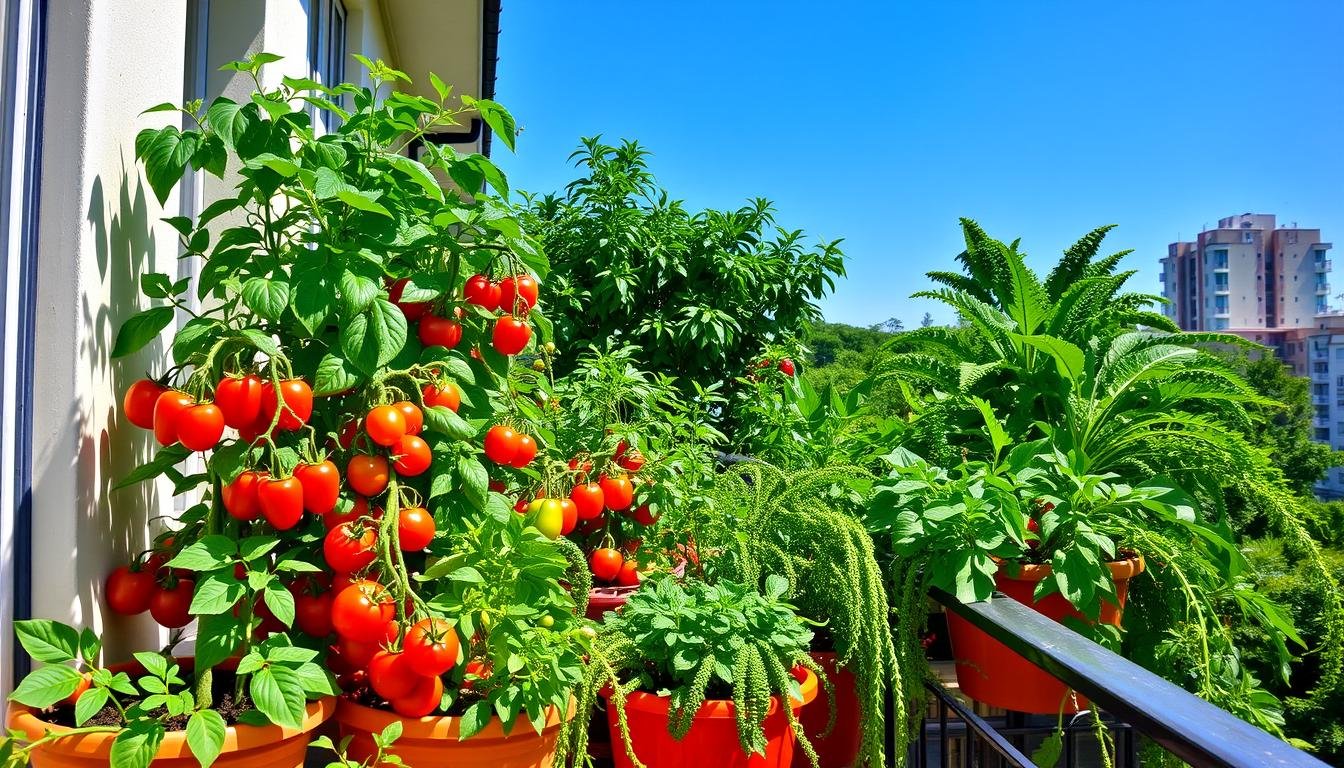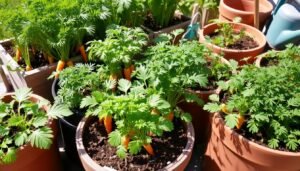Do you dream of enjoying fresh, homegrown food but have little space? This guide will help you turn your balcony into a lush garden. Learn the basics of container gardening and small-space farming. It’s perfect for both new and experienced gardeners, showing you how to grow a lot on a small balcony.
Table of Contents
Essential Planning for Your Balcony Garden
Before starting your edible landscaping project, thorough planning is key. You need to check building rules, assess sun exposure, and know your climate zone.
Checking Building Regulations and Weight Restrictions
Many urban buildings have rules about balcony gardens. It’s important to talk to your building management or homeowners’ association. They can tell you if your garden plans are okay. Also, remember the weight of soil, containers, and plants can add up.
Assessing Your Balcony’s Sun Exposure
The sunlight your balcony gets is important for plant growth. Watch your balcony during the day to see how much sun it gets. Then, pick plants that do well in that light.
Understanding Your Climate Zone
Knowing your USDA Hardiness Zone is key for choosing plants. Use Gardenate.com to plan your garden for your climate. Think about temperature, wind, and rain when picking plants for your balcony.
By following these planning steps, you can create a great edible landscaping space on your balcony. It doesn’t matter how small or limited your space is.
Getting Started with Container Selection
When you start vegetable container gardening or apartment gardening, picking the right containers is key. You can choose from lightweight plastic or fiberglass pots, fabric grow bags, or self-watering containers. Each has its own benefits.
It’s important to make sure your containers drain well. This stops water from building up and causing root rot. Starting seeds in egg cartons is a clever trick. But, investing in good seed trays can help your plants grow better.
- Containers should be at least 12 inches in diameter or the size of a 5-gallon bucket for most vegetables.
- Deep containers are recommended for root vegetables like carrots, radishes, beets, and turnips.
- Summer squash and zucchini are ideal for container gardening due to their space-saving nature.
When picking materials, plastic containers are often chosen for their cost, light weight, and ability to hold moisture. Ceramic pots are pretty but heavy and can break in cold weather. Fabric pots are light, let air in, and help roots grow well, but they need water often.
| Container Type | Pros | Cons |
|---|---|---|
| Plastic Pots | Affordable, lightweight, moisture-retaining | Limited aesthetic appeal |
| Ceramic Pots | Decorative, can be glazed for better moisture retention | Heavier, prone to cracking in cold weather |
| Fabric Pots | Lightweight, breathable, promote efficient root growth | Require consistent watering |
Choosing the right containers is vital for your vegetable container garden or apartment garden to thrive. Think about your space, the size of your plants, and how often you water. This will help you pick the best containers for your balcony garden.
“Making your own soil mix for container gardening is not only cost-effective but also provides a tailored growing medium for plant health and productivity.”
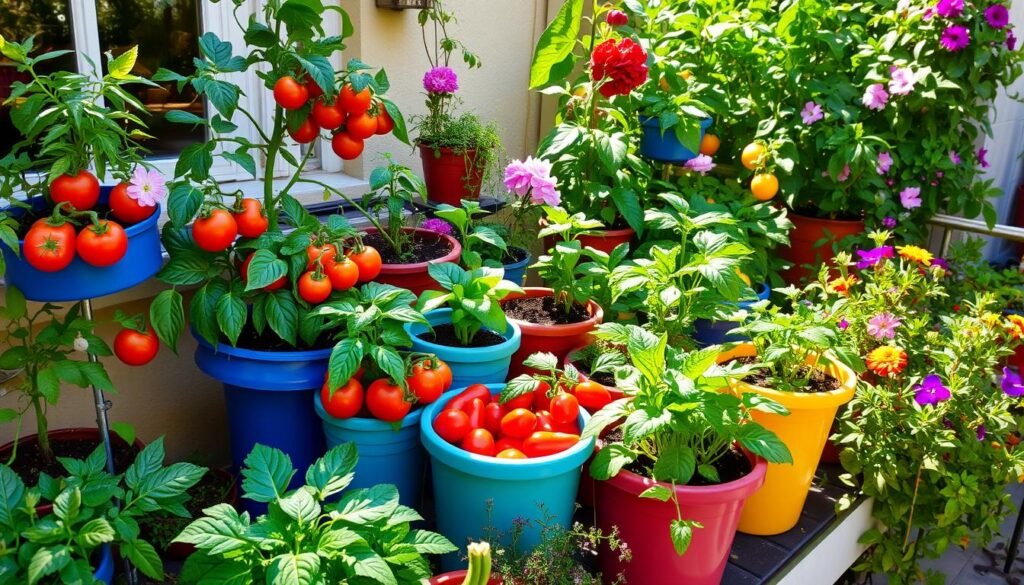
Best Soil and Fertilizer Combinations for Balcony Gardens
For a thriving balcony garden, picking the right soil and fertilizer is key. Container gardens need a special potting mix. This mix should drain well, have the right nutrients, and allow for air.
Choosing the Right Potting Mix
Go for a top-notch potting soil made for containers. These mixes have compost, coco coir, perlite, and vermiculite. They’re light, drain well, and let air in. Don’t use garden soil, as it can pack down and harm roots.
Organic vs. Chemical Fertilizers
Feed your balcony veggies with a mix of organic and chemical fertilizers. Organic fertilizers like Kellogg’s give nutrients slowly. Quick-release fertilizers, like Miracle-Gro, give an instant boost. This mix keeps your plants fed all season.
pH Balance and Soil Amendments
It’s important to check your container soil’s pH. Many potting mix ingredients, like peat moss, can make it too acidic. Add lime or other amendments to keep the pH between 6.0-7.0. This keeps your plants healthy and growing well.
| Potting Mix Ingredient | Purpose |
|---|---|
| Compost | Provides organic matter and nutrients |
| Coco Coir | Improves drainage and aeration |
| Perlite | Enhances drainage and aeration |
| Vermiculite | Retains moisture and nutrients |
| Lime | Balances soil pH |
By picking the right potting mix, using a balanced fertilizer, and keeping the pH right, you’ll have a great spot for container gardening in the city.
How to Grow Vegetables on Balcony Successfully
Start small-space gardening on your balcony to grow fresh produce. Choose easy-to-grow veggies like leafy greens, herbs, and radishes. These give quick results and regular harvests. As you get better, try different plants to see what works best for your balcony.
Think about what you like to eat when picking your veggies. Pick short-maturing ones for a steady supply. Use companion planting to make the most of your space. For example, growing leafy greens with herbs looks good and helps plants grow better.
- Leafy greens like spinach, kale, and lettuce do well in containers and give you fresh leaves often.
- Herbs such as basil, rosemary, and chives add flavor and attract good bugs.
- Radishes grow fast, often in a month, making them great for frequent picking.
With creativity and care, your balcony can become a lush grow vegetables on balcony spot. Enjoy the fruits of your small-space gardening labor. Taste the freshness of your own balcony garden.
“Gardening is a way of showing that you believe in tomorrow.”
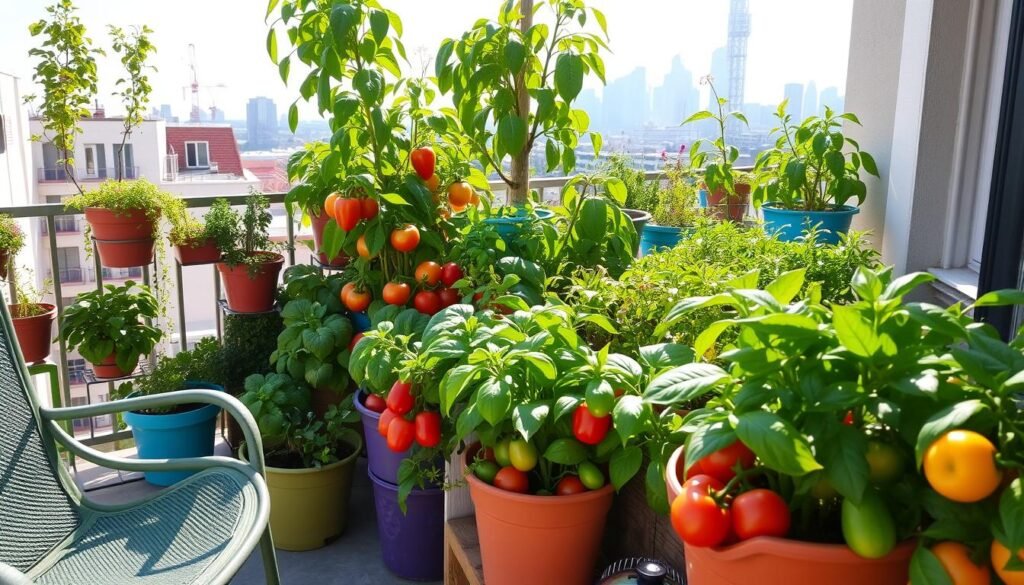
Smart Watering Systems for Container Gardens
As a budding balcony farmer or edible landscaper, managing water is essential. There are many smart ways to water your container garden. Options include drip irrigation and self-watering systems.
Drip Irrigation Setup
Drip irrigation systems save water by targeting the roots. They can cut water use by 30-50%. This makes them a smart choice for your balcony farming.
Setting up drip irrigation is easy. It provides deep watering that promotes strong roots and helps plants resist drought.
Self-Watering Solutions
Self-watering pots or Oya watering pots offer a hands-off watering solution. They have a reservoir that slowly releases water. This keeps your edible landscaping plants moist all day.
Water Conservation Tips
- Use mulch to keep soil moist and prevent water loss.
- Water deeply but less often to help plants grow strong roots.
- Choose drip irrigation or self-watering pots to save water.
- Group plants with similar watering needs for better water use.
Using these smart watering methods can make your balcony garden thrive. It also saves water. Start your journey towards sustainable edible landscaping and enjoy your urban garden’s harvest.
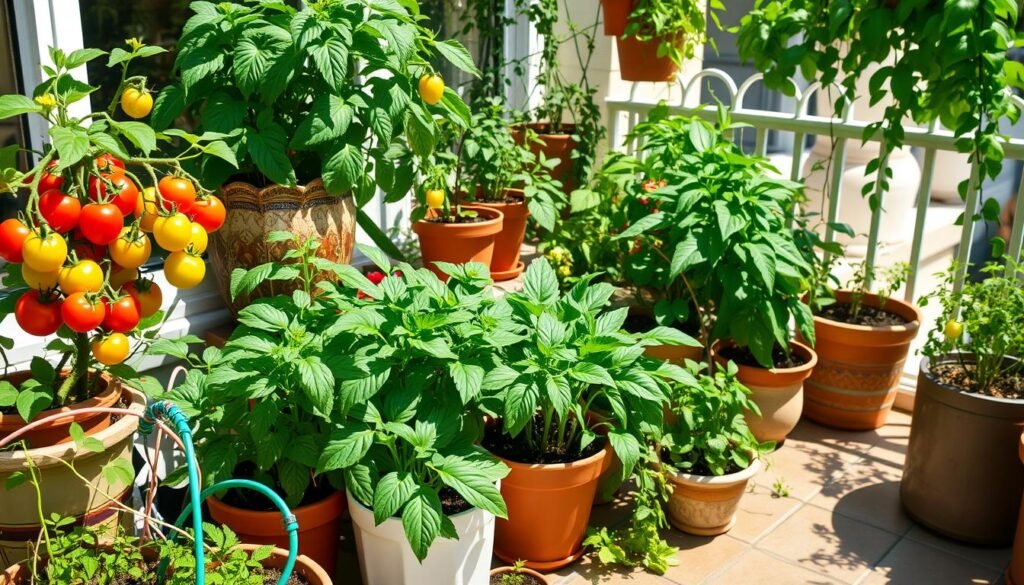
Top Vegetables for Balcony Gardens
Ready to start vertical gardening or micro-farming on your balcony? This guide will show you the best vegetables for your small urban garden.
For plants that love the sun, pick compact tomatoes, peppers, and cucumbers. Leafy greens like spinach, kale, and Swiss chard do well in partial shade. Herbs like basil, mint, and parsley are also great for your balcony garden.
If your balcony gets little sunlight, try growing beets, carrots, and salad greens. These veggies can grow well in low light. Use vertical gardening for vining plants like pole beans and peas to save space.
| Vegetable | Sunlight Requirements | Growing Tips |
|---|---|---|
| Tomatoes | Full sun | Choose compact, dwarf, or patio varieties |
| Peppers | Full sun | Opt for smaller, more manageable plants |
| Leafy Greens | Partial shade | Spinach, kale, and Swiss chard thrive in lower light |
| Herbs | Full sun to partial shade | Basil, mint, and parsley are excellent choices |
| Beets and Carrots | Partial shade | Can tolerate less sun, great for low-light balconies |
Enjoy the fun of vertical gardening and micro-farming on your balcony. With the right veggies and growing methods, you can harvest a lot in your small space.
“Many vegetables can be grown in containers in small spaces like patios, porches, balconies, or windowsills.” – Brooke Edmunds, Oregon State University Extension Service horticulturist
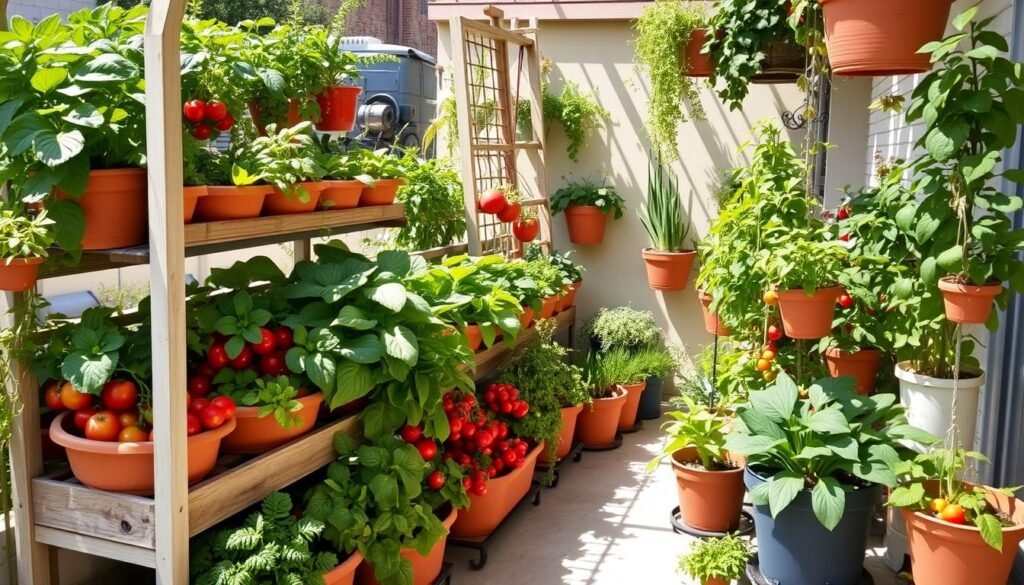
Companion Planting in Small Spaces
Discover the magic of companion planting to change your vegetable container gardening or apartment gardening projects. Pairing plants wisely can improve health, fight pests, and use space well.
Beneficial Plant Combinations
Tomatoes and basil are a great team. They taste better together and keep pests away. Basil also goes well with peppers, making them taste sweeter and keeping mosquitoes off.
For strawberries, add thyme. It keeps worms away and makes the berries taste better.
Don’t forget flowers like nasturtiums and petunias. They attract good bugs and make your garden colorful.
Space-Saving Arrangements
Grow herbs and veggies together to save space. For example, spinach and strawberries do well together. They help each other grow.
Choose containers with good drainage for your plants. Use quality potting mix and compost for nutrients. Remember, plants in containers need more water, so check them often.
Companion planting can make your small garden thrive. It turns even the smallest space into a lively, productive garden.
Year-Round Growing Schedule
To grow a successful urban garden on your balcony, you need a good plan. Knowing your local climate and using gardenate.com helps find the best times to plant vegetables.
For a constant flow of fresh veggies, try succession planting. This means planting seeds or seedlings at different times. It lets you have a steady supply of fresh produce all season.
In colder areas, using season extenders like row covers or mini-greenhouses is key. These tools can make your growing season longer. They let you grow warm-loving crops all year on your balcony.
| Season | Recommended Vegetables | Planting Timeframe |
|---|---|---|
| Spring | Lettuce, radishes, peas, spinach, carrots | March – May |
| Summer | Tomatoes, peppers, eggplant, beans, zucchini | May – August |
| Fall | Kale, Swiss chard, beets, broccoli, cauliflower | August – October |
| Winter | Microgreens, herbs, dwarf citrus, salad greens | November – February |
Plan your urban garden with your climate in mind and use season extenders. This way, you can enjoy a year-round harvest of fresh, homegrown food right from your balcony.
Common Challenges and Solutions
Starting a small-space garden or balcony farm comes with its own set of challenges. But, with the right approach, you can beat these hurdles and create a lush balcony garden. One big issue is limited space. To solve this, pick plants that grow vertically and use trellises or lattices for climbers.
Wind can also be a problem for balcony gardeners. To block the wind, set up screens or use big pots as natural barriers. Temperature changes, mainly in summer, can also be tough. Adjust how often you water and feed your plants to help them cope with these changes.
Keeping an eye out for pests and diseases is key in small gardens. Watch for common pests and deal with them quickly using natural methods. With some planning and adaptability, you can conquer balcony gardening challenges. And enjoy a rich harvest of fresh produce from your urban garden.

